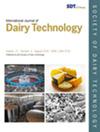A technical feasibility study evaluating sustainable enzyme-based cleaning-in-place (CIP) for removal of milk deposits formed on stainless steel surfaces during cheesemilk pasteurisation
Abstract
Background
Cleaning-in-place (CIP) is the most common method of cleaning in dairy processing, predominantly using sodium hydroxide (caustic) based nonbiodegradable detergents frequently followed by nitric acid to remove milk residues deposited during heating at high temperatures. While highly effective, this process presents sustainability challenges. Enzymes have emerged as a sustainable alternative due to lower energy and water demands and biodegradability.
Aim
This study explores the feasibility of using commercial enzymes as sustainable alternatives to traditional caustic detergents in removing milk fouling deposits from stainless steel surfaces under cheesemilk pasteurisation conditions.
Methods
Stainless steel surfaces were fouled under simulated pasteurisation conditions and cleaned using caustic and enzymatic cleaners. Enzyme stability, reusability and deactivation were assessed using an activity assay kit. Analyses included three independent trials, each with three replicate coupons. A cost analysis was applied to compare enzymatic and caustic CIP.
Major Findings
Protease-based CIP can achieve statistically similar CIP results at 50°C (0.74% residual fouling) compared with caustic at 75°C (0.1% residual fouling). Protease showed stable and active enzyme activity throughout CIP and retained an average of 93.66% activity after a CIP cycle and storage studies revealed 85.1% enzyme activity after 24 h of storage under refrigeration. Ninety-eight per cent of the enzyme was removed from the test bed system with a cold-water rinse post-CIP, and complete deactivation was achieved with a nitric acid treatment (65°C) similar to a traditional caustic and acid-based CIP protocol. Cost analysis showed that although protease procurement is slightly more expensive than caustic detergent, energy and water savings at lower operating temperatures offset this difference, confirming the economic feasibility of enzymatic CIP for fouling removal.
Scientific and Industrial Implications
Protease-based enzymatic CIP supports sustainability goals by reducing energy use, chemical waste and emissions, while maintaining cleaning effectiveness supported by a cost analysis.


 求助内容:
求助内容: 应助结果提醒方式:
应助结果提醒方式:


